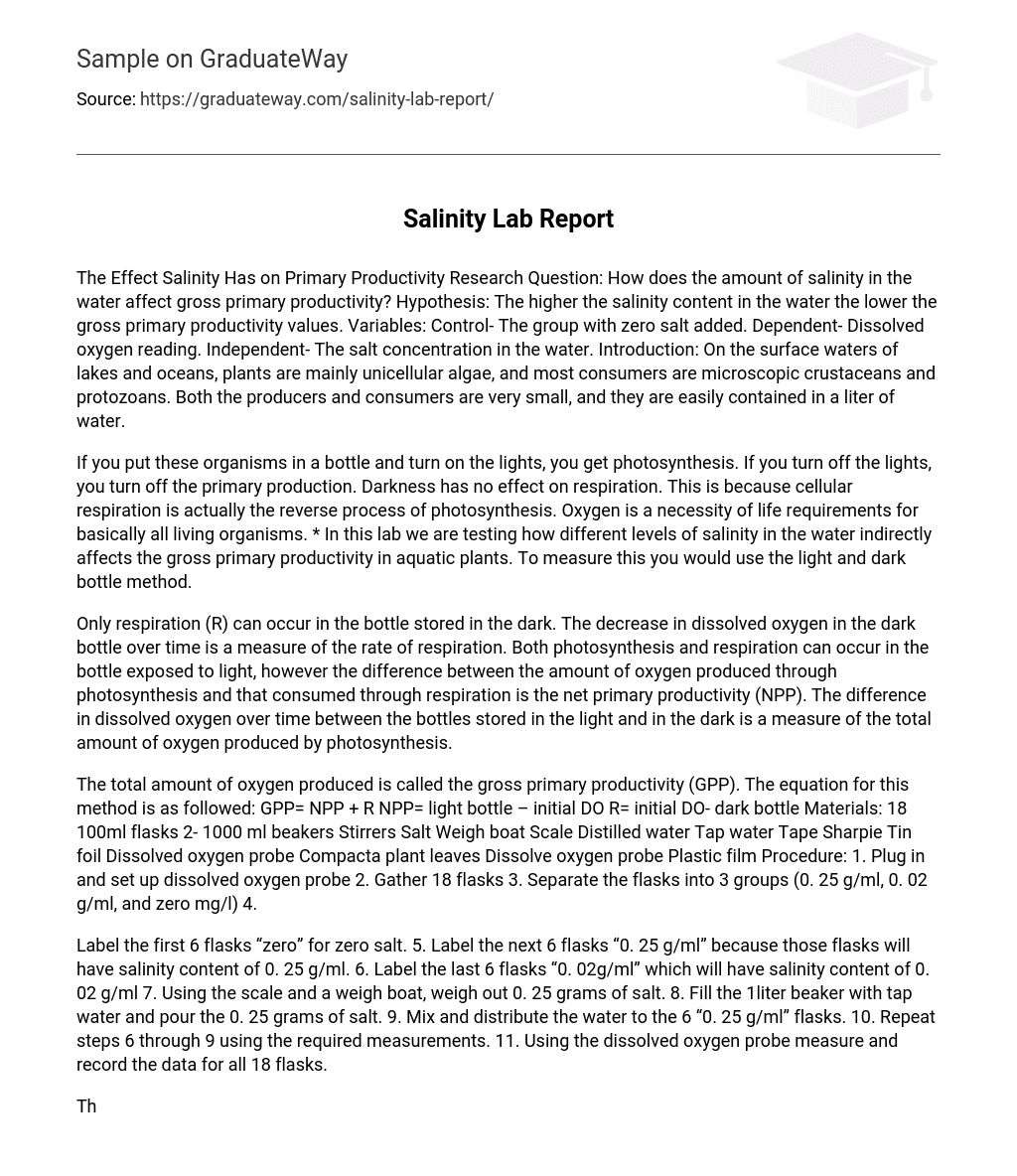The Effect Salinity Has on Primary Productivity Research Question: How does the amount of salinity in the water affect gross primary productivity? Hypothesis: The higher the salinity content in the water the lower the gross primary productivity values. Variables: Control- The group with zero salt added. Dependent- Dissolved oxygen reading. Independent- The salt concentration in the water. Introduction: On the surface waters of lakes and oceans, plants are mainly unicellular algae, and most consumers are microscopic crustaceans and protozoans. Both the producers and consumers are very small, and they are easily contained in a liter of water.
If you put these organisms in a bottle and turn on the lights, you get photosynthesis. If you turn off the lights, you turn off the primary production. Darkness has no effect on respiration. This is because cellular respiration is actually the reverse process of photosynthesis. Oxygen is a necessity of life requirements for basically all living organisms. * In this lab we are testing how different levels of salinity in the water indirectly affects the gross primary productivity in aquatic plants. To measure this you would use the light and dark bottle method.
Only respiration (R) can occur in the bottle stored in the dark. The decrease in dissolved oxygen in the dark bottle over time is a measure of the rate of respiration. Both photosynthesis and respiration can occur in the bottle exposed to light, however the difference between the amount of oxygen produced through photosynthesis and that consumed through respiration is the net primary productivity (NPP). The difference in dissolved oxygen over time between the bottles stored in the light and in the dark is a measure of the total amount of oxygen produced by photosynthesis.
The total amount of oxygen produced is called the gross primary productivity (GPP). The equation for this method is as followed: GPP= NPP + R NPP= light bottle – initial DO R= initial DO- dark bottle Materials: 18 100ml flasks 2- 1000 ml beakers Stirrers Salt Weigh boat Scale Distilled water Tap water Tape Sharpie Tin foil Dissolved oxygen probe Compacta plant leaves Dissolve oxygen probe Plastic film Procedure: 1. Plug in and set up dissolved oxygen probe 2. Gather 18 flasks 3. Separate the flasks into 3 groups (0. 25 g/ml, 0. 02 g/ml, and zero mg/l) 4.
Label the first 6 flasks “zero” for zero salt. 5. Label the next 6 flasks “0. 25 g/ml” because those flasks will have salinity content of 0. 25 g/ml. 6. Label the last 6 flasks “0. 02g/ml” which will have salinity content of 0. 02 g/ml 7. Using the scale and a weigh boat, weigh out 0. 25 grams of salt. 8. Fill the 1liter beaker with tap water and pour the 0. 25 grams of salt. 9. Mix and distribute the water to the 6 “0. 25 g/ml” flasks. 10. Repeat steps 6 through 9 using the required measurements. 11. Using the dissolved oxygen probe measure and record the data for all 18 flasks.
This quantitative data will be your initial dissolved oxygen. 12. Place one compacta plant leaf into every flask and airtight seal each flask using the plastic film. 13. Within the 3 separate groups, split the flasks into two groups. Wrap half of the group flasks in tin foil and the other half place under lights. (i. e. : The 6 “zero salinity” flasks will turn into two groups of 3. ) 14. Wait 3 days and then record findings. Use this data to calculate NPP, R, and GPP. Discussion: From the data collected, I got negative GPP and R values which shows an error in the lab/data collection.
The group that ended up with a positive gross primary productivity was the “0. 02 mg/l” group. All 3 salinity variations had relatively the same net primary productivity, with 4 mg/l being the lowest and 4. 8 mg/l being the highest. The amount of salinity in the water also showed no difference in the plants respiration. The lowest was -4. 7 mg/l in both “0. 02mg/l” and the zero salinity groups. The group with the highest amount of salt in the water had the highest respiration, which isn’t something that would happen in real life. Evaluation: A main source of error in this lab was the type of plant we used.
Either the salt didn’t affect it much or it didn’t photosynthesize as well as we planned. There was an error in the data collection because the respiration values and gross productivity values were negative which would not happen in real life. Another problem with this lab is that it takes a while to get everything set up on the first day and can almost take two days which would not work because you need to collect the initial DO and taking more than one day would not make the DO reading “initial”. Conclusion: My hypothesis was not supported.
From the results my group collected there was no significant difference in the plants productivity. It is known that too much salt in the water can damage or even kill plants; maybe our group’s research on the amount of salt was not from an accurate source. The lab experiment was not done correctly because the results are inaccurate and not possible. Errors were made and from this lab nothing can be proven as to how salinity affects plants productivity. * “Lab on Primary Productivity of Pyramimonas. ” Lab on Primary Productivity of Pyramimonas. N. p. , n. d. Web. 17 Jan. 2013.





